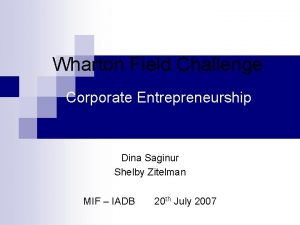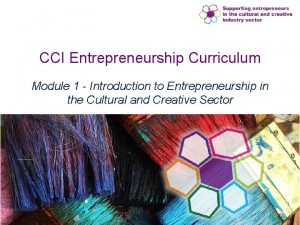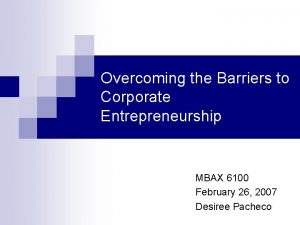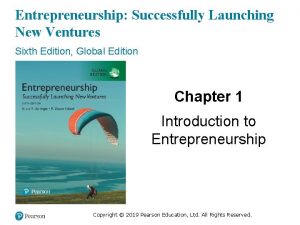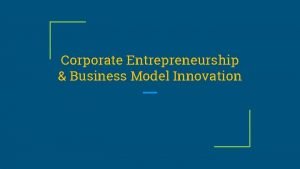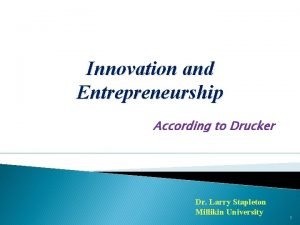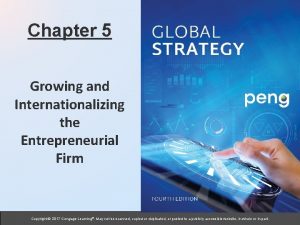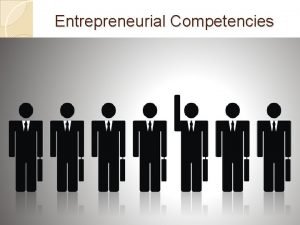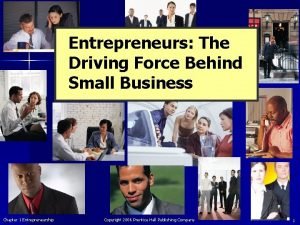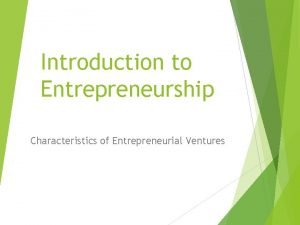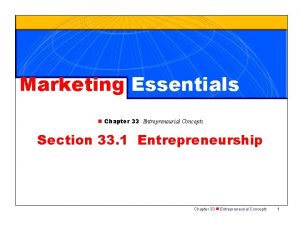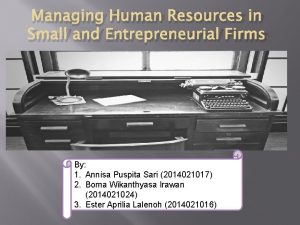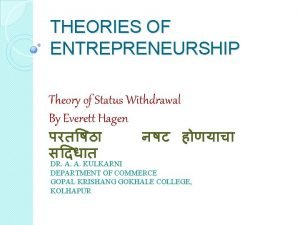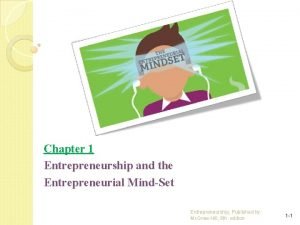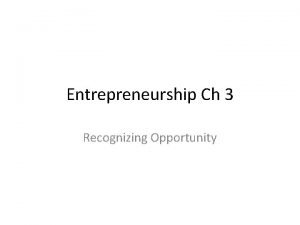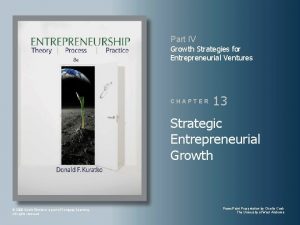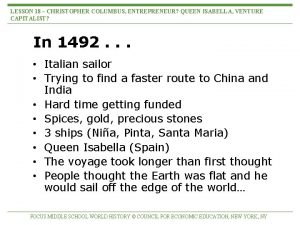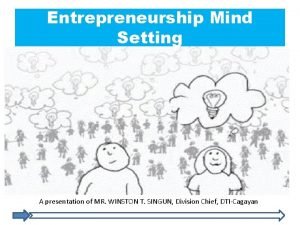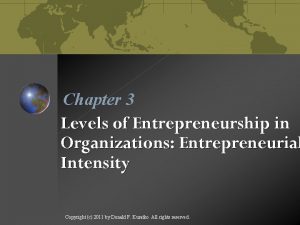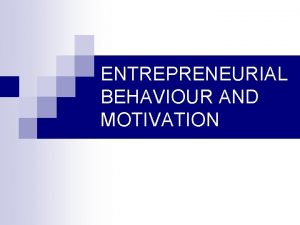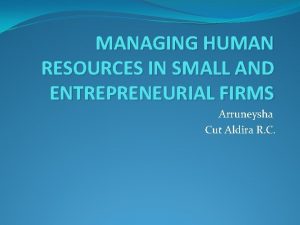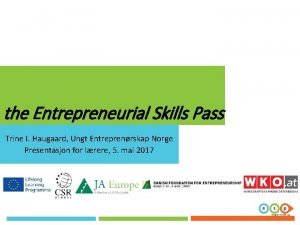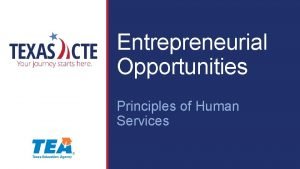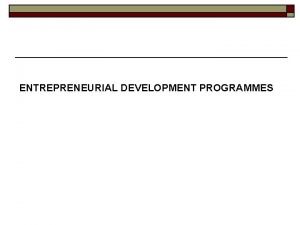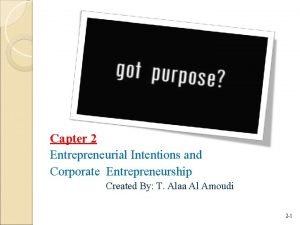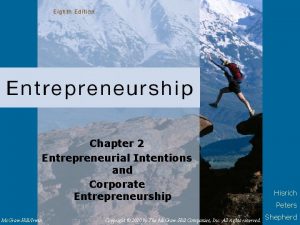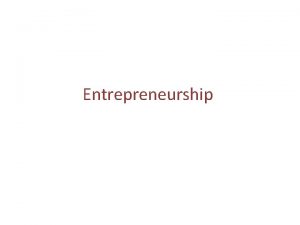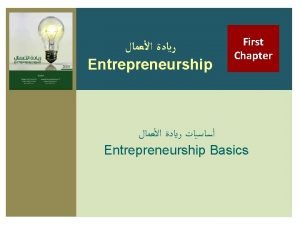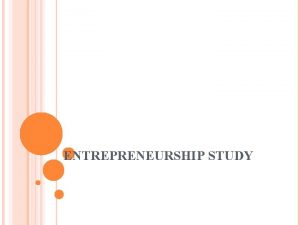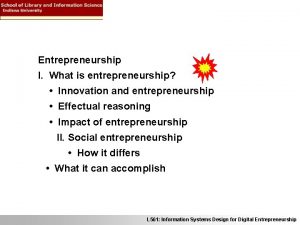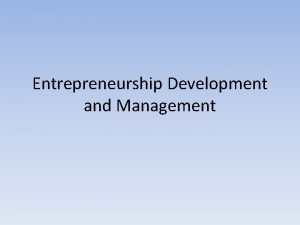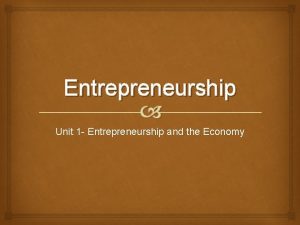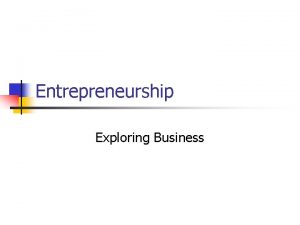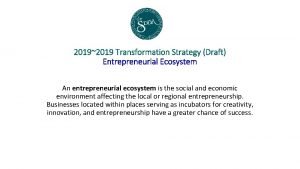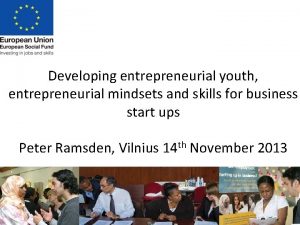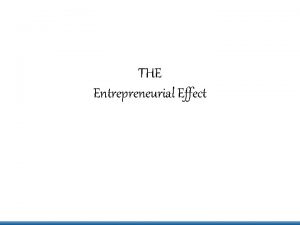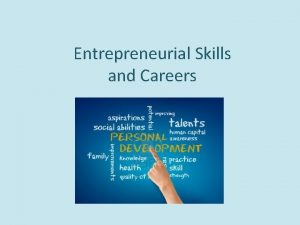Meeting the Challenge of Corporate Entrepreneurship The Entrepreneurial




































- Slides: 36

Meeting the Challenge of Corporate Entrepreneurship: The Entrepreneurial Employee Activities among Micro, Small, and Medium Enterprises in the Philippines Dr. Emilina Sarreal De La Salle University – Manila

Background of the Study • The Philippines conducted a study on entrepreneurship using the Global Entrepreneurship Monitor (GEM) framework in 2013. • The study surveyed 2, 500 adults, aged 18– 64, representing the 17 regions in the country. The survey described the entrepreneurship indicators in the country in terms of the entrepreneurial attitude, activity, and aspiration of Filipinos.

Background of the Study • In 2013, approximately 18. 5 million Filipinos were starting or running a new business while close to 6. 6 million Filipinos were engaged in a business for at least 3 1/2 years. • The Philippines exhibits the highest rate of business start-up in the Asia-Pacific and South Asia region. • On the other hand, the country has the highest business discontinuance rate. • Majority of the entrepreneurs in the Philippines are driven by necessity given the high unemployment rate and few job opportunities in the country.

Background of the Study • The average Filipino entrepreneur is young, 18– 34 years old, and married with at least secondary schooling. • Filipinos see their country as having an environment conducive to entrepreneurship. – Close to 48% of Filipinos see good opportunities to start a business in their environment.

Background of the Study • Filipinos see entrepreneurship only as income generation opportunities for the owners but not as a job generation activity for the country. – Only 0. 33% of those engaged in a new business expect to generate more than 19 jobs in the next five years while 1. 7% in an established business expect to generate more than 10 jobs in the next five years.

Background of the Study • Majority of Philippine businesses, approximately 80%, are engaged in consumer services while approximately 10% are into manufacturing, construction, and other transformative business activities. • Most of the products sold are considered new in the country, but many businesses are selling the same products.

Background of the Study • Filipino women have more positive attitudes toward entrepreneurship than men. – Fifty one percent (51%) of women see good opportunities for starting a business compared to 44. 51% of men. – More women than men also believe that they have the capability to start a business. – More men than women have a higher fear of failure from starting a new business. – There are more men in the start-up stage of the business while more women are present in an established business – Filipino women entrepreneurs are more satisfied with their work as entrepreneurs than men.

Background of the Study • The capacity of Filipinos to start a business, the high regard of Philippine society for successful entrepreneurs, and the large domestic market are main drivers of entrepreneurship in the country. • On the other hand, barriers to entrepreneurship are low and difficult access to financial support, unclear and inconsistent implementation of government policies, and the lack of capability of entrepreneurs to grow and sustain the business.

Entrepreneurial Employee Activity (EEA) • The 2013 Global Entrepreneurship Monitor (GEM) gathered data using Entrepreneurial Employee Activity (EEA) comprised of three sources: – Potential entrepreneurial employees are those who take supporting roles in the development and implementation of new ideas and activities for their employers – Entrepreneurial employees who are involved as leaders in idea development or new entrepreneurial activity for their employers – Entrepreneurial employees who are involved as leaders in the preparation and implementation of these new ideas and activities

Corporate Entrepreneurship • Corporate entrepreneurship” is a term used to describe entrepreneurial behavior inside established mid-sized and large organizations. Other popular or related terms include “organizational entrepreneurship, ” “intrapreneurship, ” and “corporate venturing. ” Copyright © 2003 John Wiley & Sons, Inc. Sekaran/RESEARCH 4 E MOD. B

Corporate Entrepreneurship and EEA • The broad definition included all the employees who in the past three years were actively involved in leading roles developing ideas as well as those employees taking leadership roles in the preparation and implementation of these ideas. The narrow definition refers only to the employees who are currently developing and entrepreneurial activity within his organization

GEM CONCEPTUAL FRAMEWORK

Findings Entrepreneurial Employee Activity - Idea Development (Full Time) 25, 00 20, 00 15, 00 10, 00 phase 1 leading role full time status REGION 5 ARMM REGION 12 CAR REGION 6 NCR REGION 4 A REGION 3 CARAGA REGION 11 REGION 10 REGION 9 REGION 8 REGION 7 REGION 4 B REGION 2 - REGION 1 5, 00 Phils Regional EEA from highest to lowest indicates that: • Region 5 or the Bicol region full time and part time employee respondents consistently claimed greater leadership roles in both idea development and implementation of these ideas in their organizations in the past three years.

Findings Entrepreneurial Employee Activity - Idea Development (Part Time) 60, 00 50, 00 40, 00 30, 00 20, 00 phase 1 leading role Part time status ARMM REGION 5 REGION 12 CAR NCR REGION 6 REGION 4 A REGION 3 CARAGA REGION 11 REGION 10 REGION 9 REGION 8 REGION 7 REGION 4 B REGION 2 - REGION 1 10, 00 Phils • Region 12 also known as the SOCCSKSARGEN followed by consistently having higher EEA rates in terms of leadership roles in both idea development and implementation of new activities in the past three years.

Findings EG Phi ls R IO EG N 1 R IO EG N R IO 2 EG N R IO 3 EG N IO 4 A R N EG 4 B R IO EG N 7 R IO EG N R IO 8 EG N R IO 9 EG N IO 10 N 11 C A A R C RM AR M AG A R N EG C R R IO EG N R IO 6 EG N IO 5 N 12 9, 00 8, 00 7, 00 6, 00 5, 00 4, 00 3, 00 2, 00 1, 00 - R phase 2 leading role full time status phase 2 leading role Part time status REGION 5 REGION 12 REGION 6 NCR CARAGA ARMM CAR REGION 11 REGION 10 REGION 9 REGION 8 REGION 7 REGION 4 B REGION 4 A REGION 3 REGION 2 12, 00 10, 00 8, 00 6, 00 4, 00 2, 00 - REGION 1 Entrepreneurial Employee Activity Preparation and Implementation Phils • ARMM or the Autonomous Region in Muslim Mindanao respondents consistently claimed leadership roles only in idea development but not in the implementation of new ideas and activities in the past three years. Entrepreneurial Employee Activity Preparation and Implementation (Full Time)

Findings REGION. . . REGION 5 REGION. . . REGION 7 CAR REGION 8 NCR REGION 6 REGION. . . ARMM REGION 3 CARAGA REGION. . . REGION 9 REGION 2 REGION 1 Phils 60, 00 50, 00 40, 00 30, 00 20, 00 10, 00 - Current involvement in new activity full time status Current involvement in new activity Part time status REGIO. . . NCR REGIO. . . ARMM CAR REGIO. . . CARAGA REGIO. . . 60, 00 50, 00 40, 00 30, 00 20, 00 10, 00 - REGIO. . . Current involvement in new activity Part time status Phils • Aside from regions 5 and 12, region 4 B also known as MIMAROPA, consistently had the highest EEA rates for current involvement in new idea development in the past 12 months. Current involvement in new activity full time status. . .

Findings • Majority or 63. 8% of the respondents are employed in private and for profit organizations. Region 1 has the highest share of its respondents working in private, for profit organizations at 92. 3% of the regional total; followed by Region 4 A at 74. 7% of the regional total. Employment by Organizational Type and Region CARAGA ARMM CAR NCR REGION 12 REGION 11 REGION 10 REGION 9 REGION 8 REGION 7 REGION 6 REGION 5 REGION 4 B REGION 4 A REGION 3 REGION 2 REGION 1 TOTAL PHIL in % 62, 4 33 66, 8 2, 1 18, 3 17, 8 70, 2 8, 4 25, 7 35, 1 73, 3 16, 9 66, 8 1, 8 66, 5 33, 5 78, 2 6, 9 52, 5 16, 5 66, 2 23, 7 48, 8 16, 2 45, 3 0 74, 7 8, 1 60, 5 4, 6 66 2, 9 92, 3 63, 8 12, 1 0 20 40 60 80 7, 7 100 Private for-profit Government Not for-profit Others Don’t know Refused 120

Findings • Majority (32. 3%) of the respondents belong to micro enterprises while about 21. 9% of the total respondents belong to small enterprises Employment by Organizational Size and Region CARAGA 3, 1 44, 8 17, 6 76, 7 ARMM 0 62, 7 CAR NCR 17 REGION 12 15, 1 REGION 11 0 REGION 10 9, 5 REGION 9 15, 4 24, 3 8, 9 51, 9 10, 6 36, 4 9, 4 24, 1 14, 5 36, 6 REGION 8 62, 1 54, 9 14, 7 0 4, 2 REGION 7 39, 4 25, 2 3, 9 REGION 6 37, 7 27, 7 5, 1 46, 3 REGION 5 REGION 4 B 23, 7 REGION 3 REGION 2 REGION 1 TOTAL PHIL % share 29, 4 37, 1 REGION 4 A 8, 6 22 12 22 37, 4 32, 3 0 20 0 -9 Micro 10 -99 Small 1, 3 0 13, 1 42, 5 7, 8 0 0 44 18, 5 21, 9 0 8, 7 40 60 80 100 120 100 -199 Medium >200 Large don't know refused

Findings Organizational Size by Gender of Workers 35 31, 6 29, 3 30 24, 9 25 in % • 32. 7% and 31. 6% of male and female respondents are employed in micro enterprises, respectively. More female respondents are employed in small enterprises than males at 24. 9% and 21. 2% of the total. 20 15 10 33, 1 32, 7 21, 2 8, 6 3, 8 5 8, 6 2 3, 1 0 0 -9 Micro 10 -99 Small 1, 2 100 -199 Medium Male >200 Large Female don't know refused

Findings • Majority or 43% of the respondents who are 5564 years old are employed by micro enterprises while small enterprises employ majority or 27. 7% of the total respondents aged 18 -24 years old Organizational Size by Age of Workers 55 -64 43 21, 8 45 -54 32, 6 18, 4 35 -44 35, 1 19 25 -34 18 -24 In % 0 30, 9 27, 9 20 3 11, 2 6, 9 22, 7 11, 3 27, 7 5, 7 40 60 80 100 120 0 -9 Micro 10 -99 Small 100 -199 Medium >200 Large don't know refused

Findings • more respondents in small enterprises have higher educational attainment than micro enterprises • Vocational, high school and elementary graduate respondents dominate micro enterprises while those with post graduate and college degrees dominate medium and large enterprises. Organizational Size by Educational Background of Workers Post Graduate College Vocational High School 12, 817, 6 12, 2 32, 7 35, 3 30, 9 18, 2 Elementary 51 Nursery. Kindergarten 46, 7 in % 0 22, 2 20, 8 13, 8 50 100 150 0 -9 Micro 10 -99 Small 100 -199 Medium >200 Large don't know refused

Findings • Potential entrepreneurial employees – Employees who are performing supporting roles in both the development of new idea or activity as well as in its preparation and implementation can be considered as potential entrepreneurial employees. – Respondents who are involved in supporting roles in the development of new idea or activity in their organizations are greater than those in leadership roles with 49. 9% assuming the support role and only 27. 1% doing the leadership roles. – Respondents who are involved in supporting roles in the preparation and implementation of new idea or activity in their organizations are also greater than those in leadership roles with 61. 6% assuming the support role and only 25. 5% doing the leadership roles

Findings Role in the Idea Development Activity by Age Role in the Idea Development Activity by Gender 60 55 -64 50 11, 1 22, 2 47, 5 46, 3 45 -54 100 0 40 35 -44 30 20, 3 40, 7 51, 3 20 10 25 -34 47, 4 52, 6 24, 2 6, 3 16 8, 5 18 -24 Male Both Female 100 0 0 Leading role Supporting role 0 Don’t know 0 20 Leading role 40 60 Supporting role 80 Both 100 Don’t know 120

Findings Role in the Idea Development Activity by Region Role in the Idea Development Activity by Educational Background ARMM 8, 7 0 CAR Post Graduate 100 0 NCR 0 45, 5 REGION 12 College 30, 7 Vocational 63, 2 21, 1 100 63, 9 54, 5 33, 3 REGION 11 0 REGION 10 0 REGION 9 0 REGION 8 0 REGION 7 0 66, 7 REGION 6 High School 57, 8 Elementary REGION 5 42, 2 0 Nursery-Kindergarten 100 0 25, 6 REGION 4 B 0 REGION 4 A 0 REGION 3 0 REGION 2 0 REGION 1 0 TOTAL PHIL 0 Leading role 20 40 Supporting role 60 Both 80 100 Don’t know 120 0 74, 4 100 27, 1 0 Leading role 49, 9 20 40 60 Supporting role 80 Both 100 Don’t know 120

Findings • Out of the total respondents engaged in both full and part time employment, employers are still the major initiator of new activity in the past three years at 32. 1% while only 14. 8% of the total respondents themselves initiate new activity in the same period. • Colleagues comprise 22% of those who initiate new activities in organizations Initiator of New Activity in the Past 3 Years by Region ARMM 8, 1 0 CAR 0 NCR 100 23, 6 REGION 12 0 REGION 11 0 REGION 10 0 REGION 9 0 REGION 8 0 REGION 7 18, 9 REGION 6 0 REGION 5 30, 8 100 51, 3 48, 7 68 34, 8 REGION 4 B 0 REGION 4 A 0 23, 8 REGION 3 0 REGION 2 0 REGION 1 0 TOTAL PHIL 0 65, 2 0 100 14, 8 0 22, 3 32, 1 20 22 40 60 80 Myself (respondent) Employer Colleague(s) Combination Don’t know 100 120

Findings Initiator of New Activity in the Past 3 Years by Gender Don’t know 23, 6 Combination 4, 7 Colleague(s) 13, 8 Male 27, 3 35 -44 11, 5 25 -34 14, 3 18 -24 15, 6 47, 6 13, 5 23, 1 30, 4 29, 2 40, 1 10 0 11, 1 45 -54 14, 1 Employer 0 55 -64 21, 8 17, 8 Myself (respondent) Initiator of New Activity in the Past 3 Years by Age 30 Female 0 40 29, 2 18, 4 16, 4 20 30, 4 50 60 70 43 20 40 22, 8 60 80 Myself (respondent) Employer Colleague(s) Combination Don’t know 100 120

Findings Initiator of New Activity in the Past 3 Years by Educational Background Initiator of New Activity in the Past 3 Years by Region ARMM Post Graduate 0 100 8, 1 0 CAR 0 NCR College 24, 1 Vocational 14 13, 8 54, 1 23, 6 REGION 12 0 REGION 11 0 REGION 10 0 REGION 9 0 REGION 8 0 REGION 7 High School 12, 4 Elementary Nursery-Kindergarten 0 100 20 40 Myself (respondent) Employer Combination Don’t know 60 80 100 Colleague(s) 120 100 51, 3 48, 7 68 0 34, 8 REGION 4 B 0 REGION 4 A 0 23, 8 REGION 3 0 REGION 2 0 REGION 1 0 TOTAL PHIL 0 22, 3 0 REGION 5 0 30, 8 18, 9 REGION 6 29 100 0 100 14, 8 0 65, 2 32, 1 20 22 40 Myself (respondent) Employer Combination Don’t know 60 80 100 Colleague(s) 120

Findings Entrepreneurial Employee Activity - Idea Development 20, 00 30, 00 18, 00 25, 00 16, 00 14, 00 20, 00 12, 00 10, 00 15, 00 17, 24 25, 00 14, 29 10, 00 6, 00 - 2, 53 - - - 2, 35 - - - - 2, 20 5, 00 - - Phils REGION 1 REGION 2 REGION 3 REGION 4 A REGION 4 B REGION 5 REGION 6 REGION 7 REGION 8 REGION 9 REGION 10 REGION 11 REGION 12 NCR CAR ARMM CARAGA 2, 00 14, 29 8, 33 4, 00 phase 1 supporting role full time status 4, 72 - 8, 33 6, 06 7, 69 - - - Phils REGION 1 REGION 2 REGION 3 REGION 4 A REGION 4 B REGION 5 REGION 6 REGION 7 REGION 8 REGION 9 REGION 10 REGION 11 REGION 12 NCR CAR ARMM CARAGA 8, 00 phase 1 supporting role Part time status

Findings Entrepreneurial Employee Activity - Preparation and Implementation 9, 00 Entrepreneurial Employee Activity - Preparation and Implementation 8, 33 8, 00 12, 00 6, 90 6, 67 7, 00 10, 00 6, 00 8, 33 8, 00 5, 00 6, 06 4, 00 6, 00 3, 00 2, 20 4, 00 2, 00 1, 38 2, 58 2, 00 - - - Phils REGION 1 REGION 2 REGION 3 REGION 4 A REGION 4 B REGION 5 REGION 6 REGION 7 REGION 8 REGION 9 REGION 10 REGION 11 REGION 12 NCR CAR ARMM CARAGA - phase 2 leading role full time status - - - - Phils REGION 1 REGION 2 REGION 3 REGION 4 A REGION 4 B REGION 5 REGION 6 REGION 7 REGION 8 REGION 9 REGION 10 REGION 11 REGION 12 NCR CAR ARMM CARAGA 1, 00 - 8, 33 phase 2 leading role Part time status

Findings EEA RATES BY AGE 14, 0 12, 0 10, 0 8, 0 EEA RATES 6, 0 4, 0 2, 0 - 12, 2 10, 4 10, 0 11, 1 120% 5, 9 4, 5 3, 8 1, 3 - - 18 -24 5, 6 100% 2, 5 1, 0 25 -34 35 -44 45 -54 55 -64 PHASE 1 LEADING PHASE 2 LEADING CURRENTLY INVOLVED IN LAST 3 YRS EEA RATES BY GENDER 30, 00 25, 00 20, 00 15, 00 10, 00 5, 00 - 10, 80 EEA phase 1 EEA phase 2 EEA current EEA phase 1 leading role involvement in new activity last 3 years 50, 00 12, 77 8, 51 16, 90 9, 09 60% 40% 0% Female 50, 00 80% 9, 6617, 86 1, 147, 14 Male 50, 00 20% 25, 00 1, 147, 14 EEA RATES BY EDUCATIONAL BACKGROUND 2, 13 2, 82 PHASE 1 PHASE 2 LEADING Pre-school/Kindergarten CURRENTLY INVOLVED IN INVOLVED LAST 3 YRS Primary/Elementary Secondary/High School Post Secondary/Vocational College Post Graduate

Correlation Analysis • There is significant correlation between full time, part time and self employment status and involvement in new activities in the past 3 years; • However, only the part time and self employed respondents are currently involved in developing new ideas. • Full time employees and self employed respondents generated new ideas in the past 3 years • Part time employees are involved in both phases 1 and 2 and occupy leading role in these new activities. The first phase consists of idea development for a new activity. This includes, for example, active information search, brainstorming on new activities and submitting your own ideas to management. • The second phase concerns preparation and implementation of a new activity. This includes for example promoting your idea, preparing a business plan, marketing the new activity or finding financial sources and acquiring a team of workers. • Self employed respondents are involved in phase 2 and take active leadership role in new activities.

Correlation Results Chi Squre Test Value ipactive * occufull ipactive * occupart ipactive * occuself ipactivenow * occupart ipactivenow * occuself ipinit * occufull ipinit * ownmge iporgsize * occufull iporgtype * occupart ipphase 1 * occupart ipphase 2 * occuself ipteamyes * occupart ipteamyes * occuself Approx. Sig. . 124 . 031 . 581 . 000 . 586 . 000 . 591 . 001 . 577 . 002 . 527 . 011 . 484 . 034 . 354 . 023 . 222 . 000 . 240 . 000 . 708 . 000 . 590 . 001 . 587 . 001 . 742 . 000 . 708 . 000

Analysis of Variance • self employed and employed Sig. . 000 Full time and Part time Sig. . 116 Gender Sig. . 542 Age Sig. . 440 ipactivenow . 003 . 327 . 625 . 226 ipphase 1 . 000 . 949 . 439 . 351 ipphase 1 role . 115 . 661 . 624 . 092 ipphase 2 . 003 . 598 1. 000 . 436 ipphase 2 role . 893 . 216 . 697 . 159 ipinit . 180 . 137 . 470 . 984 ipteamsize . 249 . 533 . 779 . 019 ipteamyes . 000 . 159 . 193 . 987 ipjob 5 yr . 370 . 407 . 750 . 602 ipactive • • • Significant differences exist across self employed and employed respondents in: – Involvement in the last 3 years in the development of new activities for main employer, such as developing or launching new goods or services, or setting up a new business unit, a new establishment or subsidiary. – Involvement in current development of new activities – Leadership in phases 1 and 2 – Active involvement in the development of new activities No significant difference exist across full and part time status in all aspects of new activities for main employer No significant difference exist across gender in all aspects of new activities for main employer Significant difference exist across age brackets in the perception of how many people will be involved in developing new activities

Causal Analysis Adjusted R R Square. 860. 739. 462 IPYES Occupart Occu self OWNMGE OPPORT SUSKILL FEARFAIL EQUALINC NBGOODC NBSTATUS NBMEDIA BSTART BJOBST Coefficientsa Standardized Coefficients Beta P value. 028 Leadership in developing new activities for employer Being part time employees Being self employed Being currently the owner of a business you help manage, self-employed, or selling any goods or services to others Perception of good opportunities for starting a business in the area where you live Possession of knowledge, skill and experience required to start a new business Absence of fear of failure from starting a business Perception that most people would prefer that everyone had a similar standard of living Perception that not most people consider starting a new business a desirable career choice Perception that those successful at starting a new business does not have a high level of status and respect Perception that the public media feature stories about successful new businesses currently trying to start a new business, including any self-employment or selling any goods or services to others with others currently trying to start a new business or a new venture for your employer as part of your normal work with others Model 1 Constant Occupart Suskill Equalinc Knowent Opport nbstatus Ownmge Nbmedia fearfail) Phreduc Bstart Nbgoodc Gender Occuself Phhhinc Hhsize bjobst . 843 -. 309 -. 292. 215 -. 276. 176. 293 -. 162. 148 -. 117 -. 132. 078 -. 064 -. 042 -. 021. 012 -. 010 Sig. . 101. 004. 107. 121. 204. 333. 384. 403. 460. 547. 609. 699. 708. 848. 891. 959. 962

Recommendations • As a result of the existing shortage in the pipeline of employees taking on leadership role in entrepreneurial activities in their respective companies, micro-level strategy such as balancing old and new way doing things is recommended. – For companies that wish to succeed with corporate entrepreneurship, the lesson is simple: Success is not an either-or proposition. New businesses should be nurtured through a series of balancing acts that combine entrepreneurship and disciplined management, short- and long term thinking, and established and new processes. Corporations must perform balancing acts in three areas: strategy, operations, and organization. (Garvin & Levesque, 2009) • As for needed government intervention, coordinated support creates the foundation for entrepreneurial success, which is a key driver for economic growth. – To achieve maximum effect, such coordination efforts should take place among a range of stakeholders, such as governments, corporations,

Thank you!
 Dina sleby
Dina sleby Corporate entrepreneurial mindset
Corporate entrepreneurial mindset Introduction to entrepreneurship module
Introduction to entrepreneurship module Barriers to corporate entrepreneurship
Barriers to corporate entrepreneurship Types of corporate entrepreneurship
Types of corporate entrepreneurship The four models of corporate entrepreneurship
The four models of corporate entrepreneurship Types of corporate entrepreneurship
Types of corporate entrepreneurship Causes for interest in corporate entrepreneurship
Causes for interest in corporate entrepreneurship Teen challenge nottingham
Teen challenge nottingham Objective of corporate governance
Objective of corporate governance Corporate meeting planner
Corporate meeting planner What is meeting and types of meeting
What is meeting and types of meeting What is meeting and types of meeting
What is meeting and types of meeting For todays meeting
For todays meeting Proposal kickoff meeting agenda
Proposal kickoff meeting agenda Drucker entrepreneurial strategies
Drucker entrepreneurial strategies Five entrepreneurial strategies
Five entrepreneurial strategies Personal entrepreneurial competencies meaning
Personal entrepreneurial competencies meaning Women entrepreneurs statistics
Women entrepreneurs statistics Characteristics of entrepreneurial ventures
Characteristics of entrepreneurial ventures Chapter 33 entrepreneurial concepts answers
Chapter 33 entrepreneurial concepts answers Managing human resources in small and entrepreneurial firms
Managing human resources in small and entrepreneurial firms Projet entrepreneurial bts mhr
Projet entrepreneurial bts mhr Withdrawal of status respect meaning
Withdrawal of status respect meaning The entrepreneurial mind lesson 1
The entrepreneurial mind lesson 1 Chapter 3 recognizing opportunity
Chapter 3 recognizing opportunity Strategic entrepreneurial growth
Strategic entrepreneurial growth Lesson 18 entrepreneurial opportunities
Lesson 18 entrepreneurial opportunities Financial preparation for entrepreneurial ventures
Financial preparation for entrepreneurial ventures Entrepreneurship mind map
Entrepreneurship mind map What are the 3 levels of entrepreneurship?
What are the 3 levels of entrepreneurship? Entrepreneurial motivation behaviour
Entrepreneurial motivation behaviour Managing human resources in small and entrepreneurial firms
Managing human resources in small and entrepreneurial firms Discovery examples
Discovery examples Entrepreneurial skills pass
Entrepreneurial skills pass Entrepreneurial opportunity in human services
Entrepreneurial opportunity in human services Unit 3 lesson 18 entrepreneurial opportunities
Unit 3 lesson 18 entrepreneurial opportunities
